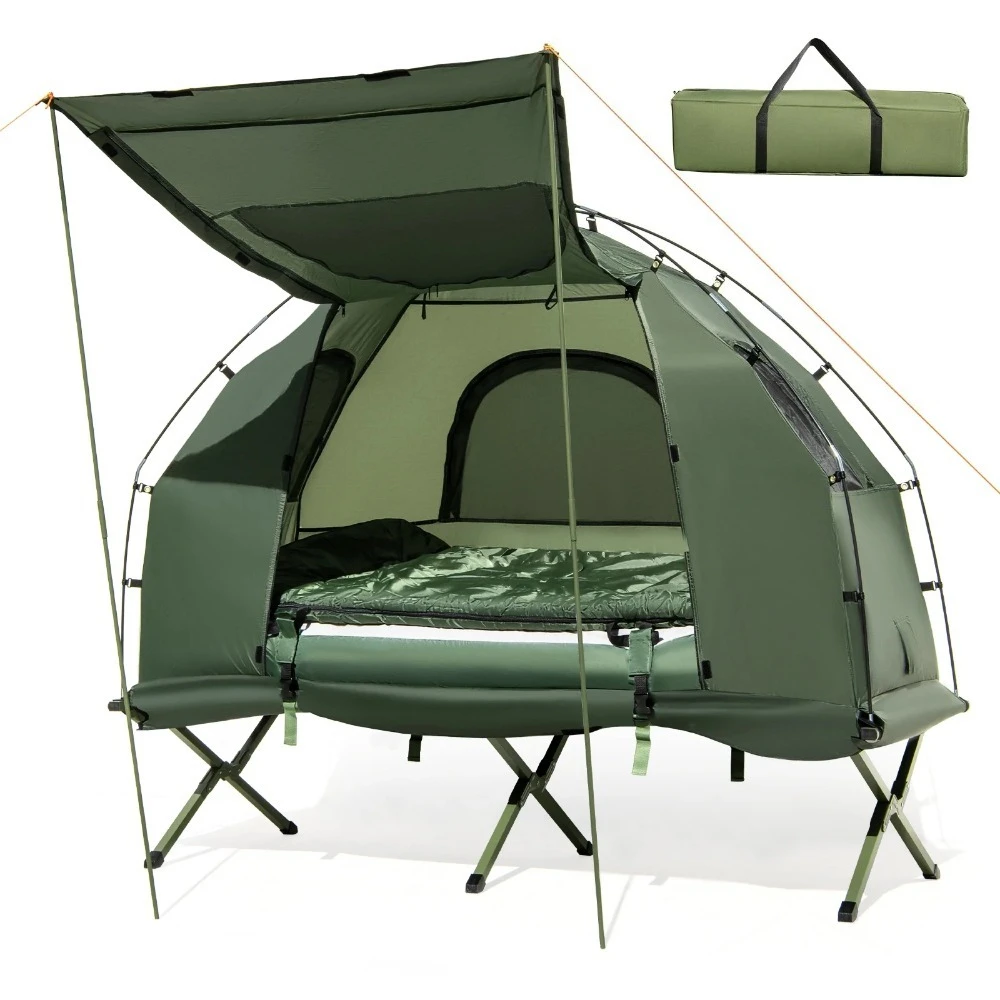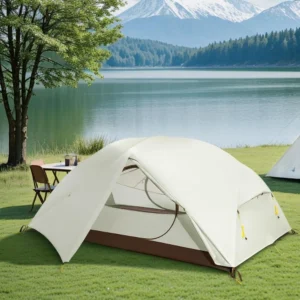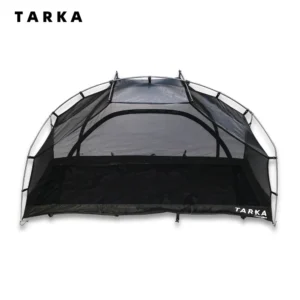Introduction: Why Windproof Tents Matter for Cold Weather Adventures
When temperatures drop and winds pick up, having proper shelter can mean the difference between an exhilarating winter adventure and a dangerous situation. Windproof tents designed specifically for cold weather aren’t just a luxury—they’re essential safety equipment for winter camping.
Unlike standard 3-season tents, true cold-weather windproof shelters feature reinforced pole structures, specialized materials, and aerodynamic designs that can withstand punishing conditions. Wind dramatically accelerates heat loss from your body and shelter—at just 20 mph, wind can make a 30°F night feel closer to 0°F due to wind chill effect, while simultaneously putting tremendous stress on your tent’s structure.
The right cold-weather tent offers critical benefits:
– Protection from dangerous wind chill that can lead to hypothermia
– Structural integrity that prevents collapse during nighttime gusts
– Reduced noise for better sleep in howling conditions
– Enhanced warmth retention through proper insulation and draft prevention
– Peace of mind that allows you to fully enjoy your winter adventure
Throughout this guide, we’ll explore the best shelter options for two campers and solo adventurers alike, examining what truly makes a tent “windproof,” and providing specific recommendations for various cold-weather scenarios.
Quick Comparison: Top Windproof Tents at a Glance
| Model | Best For | Weight | Capacity | Season Rating | Key Wind Features | Price |
|---|---|---|---|---|---|---|
| Mountain Hardwear Trango 2 | Overall Performance | 7 lbs 14 oz | 2 Person | 4-Season | 5-pole geodesic structure, reinforced guy points | $$$$ |
| The North Face Mountain 25 | Extreme Expeditions | 9 lbs 15 oz | 2 Person | 4-Season | Bomber dome design, 8 guy points, snow skirt | $$$$$ |
| Hilleberg Akto | Ultralight | 3 lbs 12 oz | 1 Person | 4-Season | Low-profile tunnel design, superior guyline system | $$$$ |
| REI Co-op Arete ASL 2 | Value | 6 lbs 5 oz | 2 Person | 4-Season | Sturdy pole crossings, multiple guy points | $$$ |
| MSR Access 2 | Winter Backpacking | 4 lbs 1 oz | 2 Person | 4-Season | Easton Syclone poles, optimized geometry | $$$$ |
| Black Diamond Eldorado 4P | Group Expeditions | 10 lbs 13 oz | 4 Person | 4-Season | Reinforced dome structure, ToddTex single-wall | $$$$$ |
This comparison provides a quick overview of our top recommendations for windproof cold-weather tents. Each has been selected for its exceptional performance in challenging winter conditions, but with different strengths to match various needs and priorities. For a more comprehensive selection of options, explore our collection of 4-season winter 2-person tents that have been thoroughly tested in demanding environments.
What Makes a Tent Truly Windproof for Cold Conditions
Understanding the key elements that create a genuinely windproof tent helps you make informed decisions beyond marketing claims. True winter windproof tents incorporate several critical design features working together as a system.
Pole Structure: The Skeletal Foundation
The pole configuration is arguably the most important factor in wind resistance. High-performance cold weather tents typically feature:
- Geodesic or semi-geodesic designs: These create multiple pole crossings that distribute wind force throughout the structure rather than concentrating it on one area.
- Pole materials: Aircraft-grade aluminum alloys or carbon composite poles offer superior strength-to-weight ratio.
- Pole diameter: Winter tents use thicker poles (often 9-10mm vs. 8.5mm for 3-season tents).
- Pole connections: Sleeve-style pole connections typically provide more stability than clips in high winds.
Tent Shape and Aerodynamics
A tent’s overall shape dramatically impacts its wind-shedding ability:
– Low-profile designs: Lower heights create less wind resistance.
– Dome or tunnel shapes: Rounded surfaces deflect wind better than flat walls.
– Symmetrical designs: Equal wind resistance from multiple directions.
– Limited flat surfaces: Less area for wind to push against.
Fabric and Material Considerations
The tent body itself must withstand powerful forces:
– Higher denier ratings: 70D+ fabrics offer significantly better durability than lightweight 20D materials.
– Ripstop construction: Prevents small tears from becoming catastrophic failures.
– Reinforced stress points: Extra fabric at corners and pole insertion points.
For extreme conditions, specialized windproof winter tents incorporate additional features like double-stitched seams, reinforced guy-out points, and specialized coatings to handle intense weather. These heavy-duty 4-season tents represent the pinnacle of protection for serious winter adventurers.
The Best Windproof Tents for Cold Weather Camping
Best Overall: Mountain Hardwear Trango 2
The Mountain Hardwear Trango 2 represents the gold standard for balancing weather protection, livability, and manageable weight in a winter tent. This legendary shelter has protected mountaineers and winter campers for decades with continual refinements.
Key Specifications:
– Weight: 7 lbs 14 oz (3.6 kg)
– Capacity: 2 Person
– Floor Area: 40 sq ft
– Peak Height: 38 inches
– Season Rating: 4-Season
The Trango’s outstanding wind resistance comes from its 5-pole geodesic design that creates multiple intersection points, allowing it to withstand severe weather conditions. The 70D nylon fly and 70D nylon floor provide exceptional durability while the DAC Featherlite NSL poles offer an ideal balance between strength and weight.
For cold weather, the tent features adjustable vents that help manage condensation without creating uncomfortable drafts. The two vestibules provide 13 sq ft of protected storage space, allowing you to keep gear out of the elements without sacrificing interior living space.
Pros:
– Exceptional stability in high winds
– Durable materials throughout
– Excellent ventilation system
– Spacious interior for a mountaineering tent
– Two doors and vestibules for convenience
Cons:
– Heavier than some alternatives
– Premium price point
– Setup takes practice to master
Ideal for serious winter adventurers who need reliable protection and aren’t counting every ounce, the Trango excels in situations where mastering two-person lightweight tent setup in challenging conditions is crucial to safety.
Best for Extreme Expeditions: The North Face Mountain 25
When facing the absolute worst conditions imaginable, The North Face Mountain 25 stands as the ultimate fortress against the elements. This expedition-grade shelter is purpose-built for high-altitude mountaineering, polar expeditions, and environments where failure is not an option.
Key Specifications:
– Weight: 9 lbs 15 oz (4.5 kg)
– Capacity: 2 Person
– Floor Area: 32 sq ft
– Peak Height: 41 inches
– Season Rating: 4-Season+
The Mountain 25’s bombproof construction begins with its time-tested dome design featuring intersecting poles that create exceptional structural integrity. Its 40D nylon fly with 1500mm PU/silicone coating and 70D nylon floor with 10,000mm PU coating provide outstanding weather protection.
For extreme cold, the tent includes dual doors with covered vents to allow minimal air exchange while preventing snow entry. The high-low ventilation system manages condensation even in the harshest conditions, while eight internal pockets keep essentials organized during extended storms.
Pros:
– Virtually indestructible in proper use
– Outstanding snow-loading capability
– Proven on expeditions worldwide
– Easy setup even with gloves
– Excellent interior organization
Cons:
– Heavy compared to less robust options
– Bulky when packed
– High investment cost
The Mountain 25 excels in scenarios where failure could be catastrophic. It’s the preferred choice of many professional guides and expedition leaders operating in the world’s most extreme environments. Browse our selection of mountaineering tents for this and other expedition-worthy options.
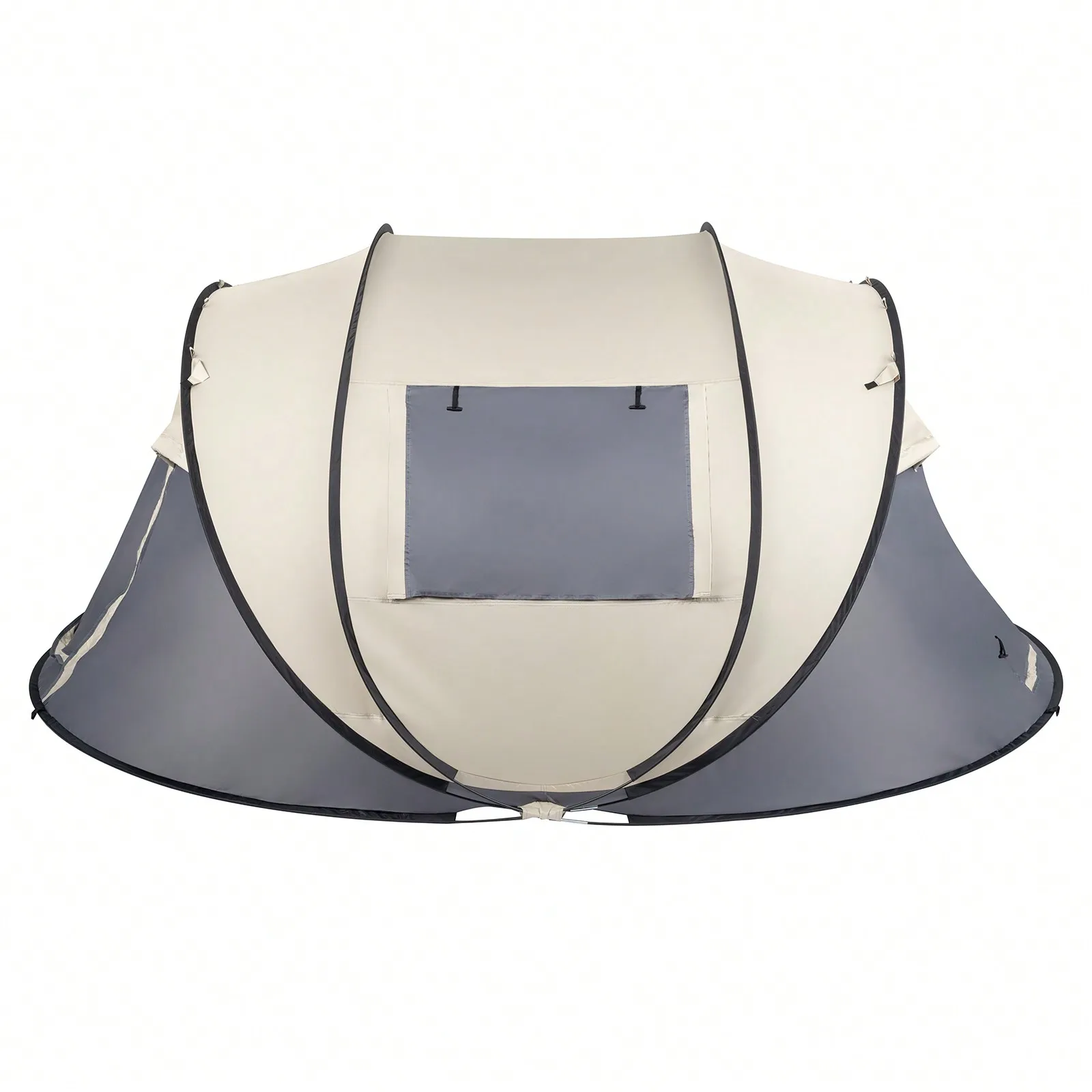
Best Ultralight Option: Hilleberg Akto
For solo winter adventurers who need to balance weight with protection, the Hilleberg Akto delivers exceptional performance in a remarkably light package. This Swedish-engineered shelter brings serious weather resistance without the weight penalty of most winter tents.
Key Specifications:
– Weight: 3 lbs 12 oz (1.7 kg)
– Capacity: 1 Person
– Floor Area: 18 sq ft
– Peak Height: 36 inches
– Season Rating: 4-Season
The Akto achieves its impressive wind resistance through a sophisticated hoop design with a single main pole and short crossing pole. This creates a low-profile tunnel structure that excels at shedding wind from its ends while the Kerlon 1200 outer fabric provides outstanding tear resistance despite its light weight.
For cold weather performance, the tent features a breathable inner canopy with high bathtub floors to prevent drafts. The spacious vestibule offers 8.6 sq ft of protected storage space—crucial for winter gear management.
Pros:
– Exceptional strength-to-weight ratio
– Remarkably fast setup
– True 4-season protection under 4 pounds
– Excellent ventilation options
– Packs down surprisingly small
Cons:
– Tight quarters for larger individuals
– Limited headroom
– Premium price point
The Akto is perfect for winter backpacking, ski touring, and alpinism where every ounce matters but protection cannot be compromised. It’s a favorite among adventurers embarking on compact winter tents for alpine hiking where mobility and safety must be balanced.
Best Value: REI Co-op Arete ASL 2
The REI Co-op Arete ASL 2 offers impressive cold-weather performance at a significantly lower price point than most comparable 4-season tents. This accessible option makes serious winter camping more attainable without compromising essential protection.
Key Specifications:
– Weight: 6 lbs 5 oz (2.9 kg)
– Capacity: 2 Person
– Floor Area: 32.9 sq ft
– Peak Height: 43 inches
– Season Rating: 4-Season
The Arete achieves reliable wind resistance through a sturdy pole configuration with a cross-pole design and additional hub structure. The 30D ripstop nylon fly with 1500mm waterproof coating provides good weather protection while keeping costs reasonable.
For cold weather, the tent features an adjustable ceiling vent and low vents that create sufficient air circulation to manage condensation. The single vestibule (8.7 sq ft) provides adequate covered storage for winter essentials.
Pros:
– Excellent protection-to-price ratio
– Relatively easy setup
– Good ventilation system
– Respectable weight
– Backed by REI’s guarantee
Cons:
– Single vestibule limits gear organization
– Less durable than premium options
– Moderate condensation management
The Arete ASL 2 is ideal for weekend winter warriors, those new to cold weather camping, or anyone who needs occasional 4-season performance without breaking the bank. Check out our collection of winter camping tents to compare this value option with other choices.
Best for Winter Backpacking: MSR Access 2
The MSR Access 2 brilliantly bridges the gap between lightweight backpacking tents and full expedition shelters, making it perfect for mobile winter adventures where weight matters but protection is non-negotiable.
Key Specifications:
– Weight: 4 lbs 1 oz (1.8 kg)
– Capacity: 2 Person
– Floor Area: 29 sq ft
– Peak Height: 42 inches
– Season Rating: 4-Season
The Access achieves its impressive wind performance through proprietary Easton Syclone poles that flex instead of breaking under stress. Its dome design with strategic crossing points creates excellent structural integrity while its 20D ripstop nylon fly with Durashield coating balances protection and weight.
For cold weather performance, the tent features limited mesh panels to retain warmth while providing just enough ventilation to control condensation. The generous vestibule (17.5 sq ft) offers substantial protected storage despite the tent’s light weight.
Pros:
– Outstanding weight-to-protection ratio
– Easton Syclone poles outperform aluminum in cold
– Quick setup with color-coded poles
– Surprisingly spacious interior
– Excellent packed size
Cons:
– Less robust than heavier expedition tents
– Limited ventilation in extremely humid conditions
– Higher price point than 3-season options
The Access 2 excels for winter backpacking trips, ski touring adventures, and alpine approaches where mobility is critical but weather protection cannot be compromised. It’s ideal for those questioning if a 2-person tent is actually big enough for their winter adventures, offering reasonable space at an impressive weight.
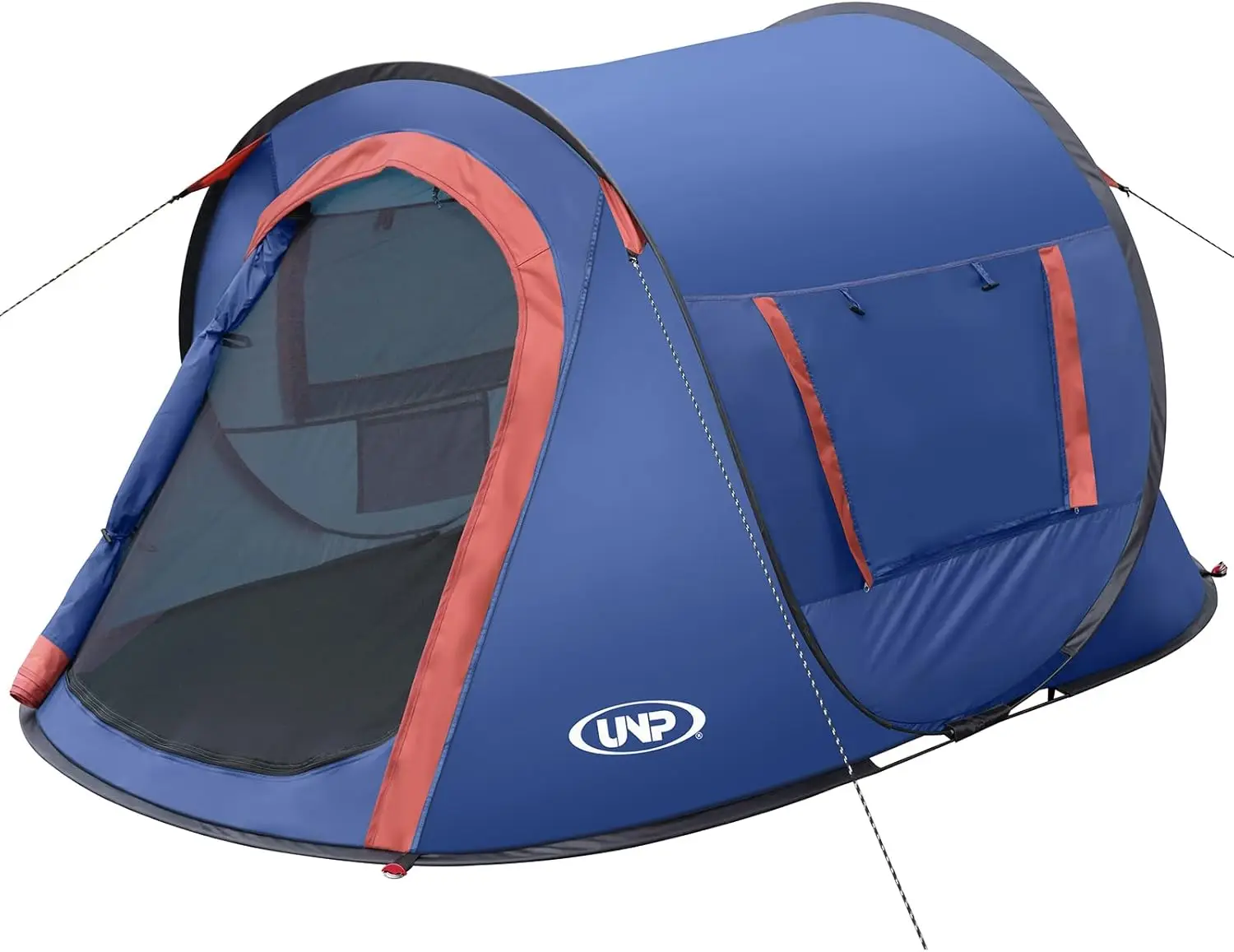
Best for Group Expeditions: Black Diamond Eldorado 4P
For small groups facing serious winter conditions, the Black Diamond Eldorado 4P offers exceptional protection with enough space for comfort during extended trips. This expedition-worthy shelter scales up the legendary Eldorado design for group adventures.
Key Specifications:
– Weight: 10 lbs 13 oz (4.9 kg)
– Capacity: 4 Person
– Floor Area: 57.8 sq ft
– Peak Height: 51 inches
– Season Rating: 4-Season+
The Eldorado achieves outstanding wind resistance through its time-tested dome design with crossed internal poles creating exceptional structural integrity. Its proprietary ToddTex single-wall fabric eliminates the weight of a separate fly while still providing excellent weather protection.
For cold weather performance, the tent features adjustable vents at multiple heights to create effective air circulation while maintaining warmth. The spacious interior allows for comfortable waiting out storms with multiple people, a crucial safety factor in extreme environments.
Pros:
– Exceptional strength-to-weight ratio for a 4-person shelter
– Single-wall design speeds setup in adverse conditions
– Generous internal space for gear and occupants
– Outstanding snow-loading capability
– Interior pole setup keeps fabric dry during assembly
Cons:
– Single-wall design requires more condensation management
– Substantial packed size and weight
– Premium price point
The Eldorado 4P excels for small expedition teams, mountaineering courses, or family winter camping where group safety depends on robust shelter. The essential benefits of windproof tents in snow become even more crucial when protecting multiple people in remote locations.
Buyer’s Guide: Essential Features for Cold Weather Wind Protection
Critical Wind Resistance Elements to Consider
When evaluating a tent’s ability to withstand powerful winter winds, several key structural elements make the difference between confidence and concern:
Pole Structure Varieties:
– Geodesic designs provide ultimate stability through multiple crossing points that distribute force throughout the entire structure.
– Tunnel designs offer excellent directional wind resistance when properly oriented and staked.
– Dome designs with at least 3 poles create good all-around stability with reasonable weight.
– Semi-geodesic hybrids balance weight and strength for versatile winter use.
Pole Materials Matter:
High-quality winter tents use premium aluminum alloys (often DAC Featherlite or similar) that maintain flexibility in freezing temperatures. Carbon fiber poles offer weight savings but can be brittle in extreme cold. The larger the diameter (typically 9-10mm for winter tents), the more rigid and wind-resistant the structure becomes.
Shape Optimization:
Low-profile tents with aerodynamic shapes dramatically outperform taller, boxier designs in high winds. The ideal winter tent presents minimal surface area to prevailing winds while maintaining adequate interior space. Curved surfaces deflect wind more effectively than flat panels.
Guy Line Systems:
Advanced guy line configurations with multiple attachment points make a substantial difference in wind performance. Look for tents with at least 6-8 reinforced guy points and reflective, non-stretch cord. The best waterproof backpacking tents include pre-attached guy lines with tensioners for quick deployment.
Cold Weather Performance Factors
Beyond wind resistance, several features specifically address the challenges of cold temperatures:
Insulation Strategy:
– Double-wall construction creates a crucial air gap that improves thermal efficiency.
– Reduced mesh in the inner tent body helps retain warmth.
– Overlapping door designs minimize heat loss during entry/exit.
– Full coverage rainflies that extend to the ground prevent drafts.
Condensation Management:
Proper ventilation becomes critically important in winter as warm breath meets cold tent walls. Look for adjustable vents positioned to create high-low airflow without introducing uncomfortable drafts. Strategic placement of gear can create additional insulation barriers against the coldest walls.
Vestibule Design:
Winter camping requires substantial gear, making vestibule design crucial. The best cold weather tents offer vestibules that:
– Provide adequate cooking space away from the sleeping area
– Allow for gear organization and snow removal
– Feature reinforced stake points to maintain tension in high winds
– Include snow flaps that can be buried to prevent drafts
Proper vestibule design makes extended winter camping substantially more comfortable and safe, particularly when choosing the ultimate compact shelter for two adventurers with substantial gear requirements.
Materials and Durability Considerations
The materials used in cold weather tents directly impact their performance and longevity:
Fabric Denier and Construction:
Denier (D) refers to the thickness of individual threads in a fabric—higher numbers indicate stronger, heavier materials. Winter tents typically use:
– Fly materials: 30D to 70D ripstop nylon or polyester
– Floor materials: 40D to 70D with higher waterproof ratings
– Inner canopy: 20D to 40D breathable nylon with minimal mesh
Ripstop construction incorporates stronger threads in a grid pattern to prevent tears from spreading—essential in harsh conditions.
Waterproofing Treatments:
Cold weather tents typically feature:
– Polyurethane (PU) coatings with ratings from 1,200mm to 10,000mm
– Silicone impregnation for enhanced tear strength and water resistance
– DWR (Durable Water Repellent) treatments to prevent saturation
Critical Seam Construction:
Look for fully taped seams with additional reinforcement at high-stress points. Double-stitched seams with protective seam tape provide essential protection from moisture intrusion at vulnerable junctions.
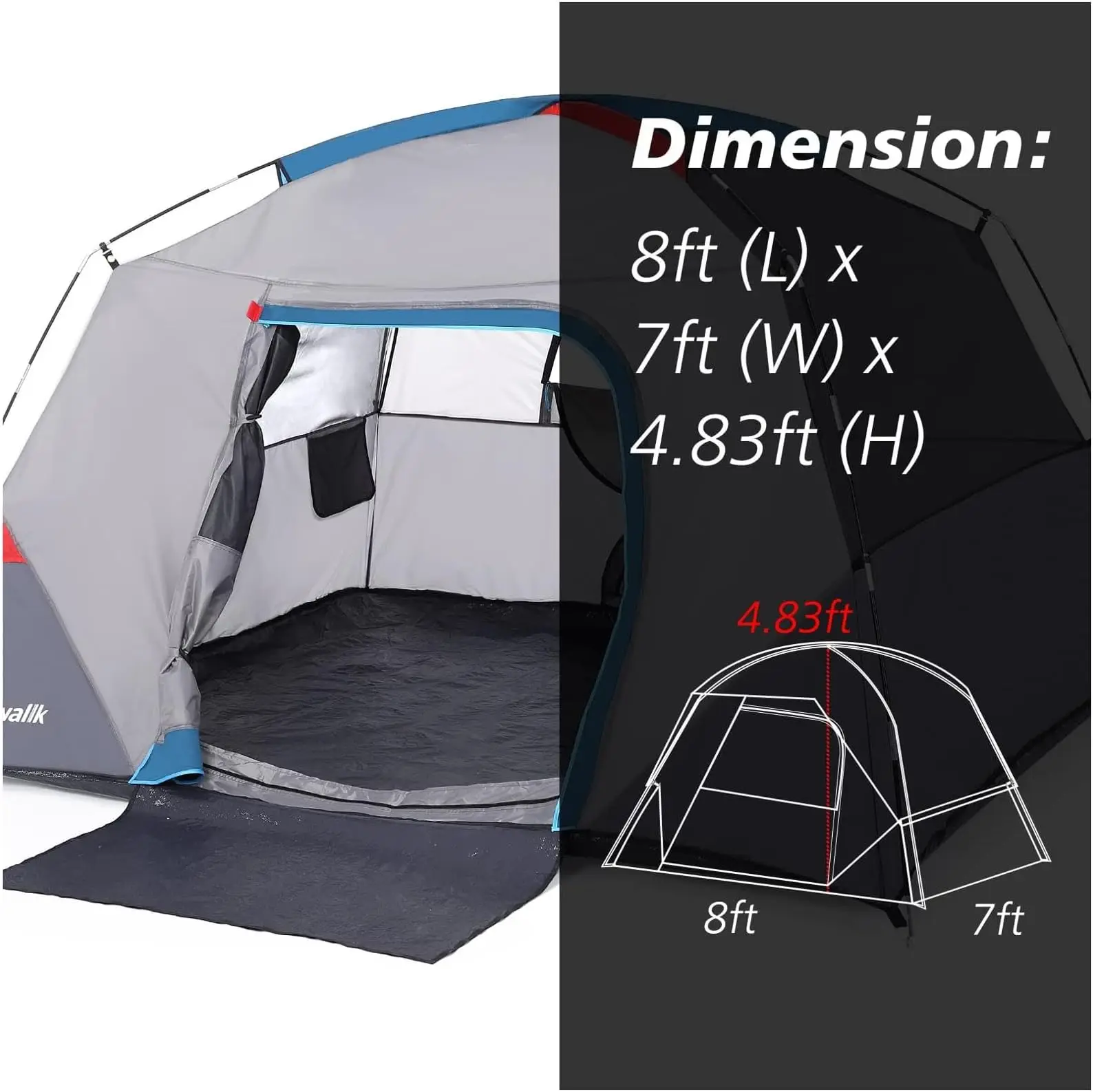
Weight vs. Protection: Finding Your Balance
The fundamental challenge in selecting winter tents is balancing adequate protection against excessive weight:
Trip-Specific Considerations:
– Basecamp-style trips can prioritize durability and space over weight
– Mobile adventures (ski touring, winter backpacking) demand weight efficiency
– Expedition scenarios require redundancy and maximum protection
– Weekend winter camping can often balance these factors more evenly
Minimum Protection Thresholds:
Even when prioritizing weight savings, certain minimum requirements should not be compromised:
– Full rainfly coverage to the ground
– Adequate pole strength for anticipated wind conditions
– Sufficient vestibule space for gear protection
– Ventilation options for condensation management
For those seeking the ultimate balance between protection and portability, specialized ultralight windproof mountaineering shelters offer innovative solutions that minimize weight while maintaining essential protection in specific conditions.
Mastering Winter Camp Setup for Maximum Wind Protection
Proper site selection and tent setup can dramatically improve your shelter’s performance in windy conditions:
Strategic Site Selection:
– Choose locations with natural windbreaks (rock formations, dense trees, terrain depressions)
– Avoid ridge tops, valley bottoms, and narrow passages that funnel wind
– Look for sites with deep snow that allows for construction of protective snow walls
– Consider sun exposure for daytime warming but beware of unstable snow conditionsOptimal Tent Orientation:
– Position the tent with its narrowest, strongest end facing the prevailing wind
– For tunnel tents, this is critical—the long side should never face strong winds
– For dome tents, position doors away from the wind when possible
– Anticipate wind direction changes that often occur at nightSecure Anchoring Techniques:
– Use snow stakes, deadman anchors, or buried objects (stuff sacks filled with snow) for secure anchoring
– Create T-anchor points by burying sticks or poles horizontally in snow trenches
– Compact snow around stakes or anchors and allow it to harden before tightening
– Use all available guy points—winter is not the time to skip stakesProtective Snow Wall Construction:
– Build snow walls on the windward side of your tent (2-3 feet high)
– Maintain at least 2 feet of clearance between walls and tent for drifting snow
– Angle walls to deflect wind upward rather than creating a vertical barrier
– Pack the snow firmly and allow time for it to set before relying on it
The specialized designs of ultralight trekking pole tents require particular attention to proper setup, as their stability depends heavily on correct tensioning and stake placement.
Lightweight Backpacking Tent, Ultralight Backpacking Tent, Waterproof Backpacking Tent
$391.05 Select options This product has multiple variants. The options may be chosen on the product pageHeavy Duty 4 Season Tent, Mountaineering Tent, Winter Camping Tent
$870.40 Select options This product has multiple variants. The options may be chosen on the product pageUltralight Backpacking Tent, Ultralight Dome Tent, Winter Camping Tent
Price range: $369.63 through $370.07 Select options This product has multiple variants. The options may be chosen on the product pageHeavy Duty 4 Season Tent, Ultralight Freestanding Tent, Winter Camping Tent
$3,722.66 Select options This product has multiple variants. The options may be chosen on the product pageUltralight Backpacking Tent, Ultralight Trekking Pole Tent
Price range: $350.87 through $351.98 Select options This product has multiple variants. The options may be chosen on the product pageHeavy Duty 4 Season Tent, Winter Camping Tent
$638.69 Select options This product has multiple variants. The options may be chosen on the product page
Advanced Cold Weather Tent Management
Managing Condensation in Freezing Conditions
Condensation can quickly transform from inconvenience to safety hazard in freezing conditions as moisture freezes into ice crystals inside your tent:
Understanding the Science:
Warm, moist air from breathing and body heat rises and condenses on cold tent surfaces. In winter, this creates frost or ice that can fall onto sleeping bags and gear, compromising insulation.
Prevention Strategies:
– Crack vents even in the coldest conditions—counterintuitive but essential
– Position sleeping areas away from tent walls where condensation collects
– Cook outside the tent whenever possible to reduce moisture introduction
– Minimize bringing wet gear inside; shake off snow before entering
– Use a small camp towel to wipe down interior walls before frost accumulates
Morning Management:
– Gently brush ice crystals from tent walls before they melt during pack-up
– Turn the tent inside-out in sunshine when possible to dry before packing
– Separate wet components (fly, inner tent) during transportation
– Dry thoroughly at home before storage
Creating a Comfortable Living Space in Harsh Conditions
Efficient tent management dramatically improves comfort during extended winter stays:
Space Optimization:
– Establish dedicated zones for sleeping, cooking (in vestibule only), and gear storage
– Use stuff sacks hanging from interior loops as organization pockets
– Keep frequently used items accessible without disturbing insulation layers
– Position sleeping pads to minimize contact with tent walls
Thermal Efficiency Techniques:
– Create a “cold well” by digging out the tent floor 1-2 feet where possible
– Use packs and gear as additional insulation barriers along walls
– Place foam pads under inflatable sleeping pads for additional ground insulation
– Position body heat optimally—two people sleeping head-to-toe conserves heat
Psychological Comfort:
– Maintain tidiness to reduce feelings of confinement
– Establish clear routines for tent operations to minimize stress
– Bring small comfort items that improve morale (quality lighting, music)
– Create proper seating arrangements for extended storm days
Frequently Asked Questions About Windproof Winter Tents
Do I really need a 4-season tent for cold weather camping?
For true winter conditions with potential snow and significant wind, yes. Three-season tents lack the pole strength, reduced mesh, and snow-shedding designs needed for safe winter use. While you might get away with a 3-season tent in mild winter conditions, the risk isn’t worth the savings when temperatures drop and winds pick up.
What do wind ratings on tents actually mean?
Wind ratings, when provided, typically indicate the maximum wind speed the tent withstood in controlled testing. However, there’s no standardized testing protocol across the industry, making direct comparisons difficult. More reliable indicators are pole structure, guy point quantity, and real-world testing in alpine environments.
How can I repair a tent in freezing conditions?
Carry specialized cold-weather repair supplies: tenacious tape works when standard adhesives fail, silicone-based sealants remain flexible in cold, and zip ties can create temporary pole splints. Pre-cut repair patches can be applied with body heat to warm the adhesive. Always practice repairs at home before relying on field fixes.
Can I use a 3-season tent with extra guy lines instead of buying a winter tent?
This approach significantly increases risk. While additional guy lines help, they can’t compensate for fundamental design limitations like insufficient pole strength, excess mesh, or inadequate snow-loading capability. The money saved won’t matter if your shelter fails in dangerous conditions.
What’s the best way to cook safely in winter camping conditions?
Always cook in well-ventilated vestibules with the door partially open, never inside the sleeping area. Position the stove on a stable platform away from flammable materials. Use a carbon monoxide detector for safety. In extreme conditions, consider creating a separate snow kitchen away from your sleeping tent.
Winter Tent Care and Maintenance for Longevity
Proper care dramatically extends the life of your investment in winter camping gear:
Post-Trip Essentials:
– Never store a tent damp—even slight moisture leads to mildew and degraded waterproofing
– Dry completely by setting up indoors or hanging components separately
– Clean dirty areas with mild soap and water, never harsh detergents
– Remove snow and ice by brushing gently rather than scraping
Cold-Specific Maintenance:
– Inspect poles for micro-cracks that can develop in freezing conditions
– Test zippers and lubricate with specialty zipper lubricant if sticking occurs
– Check seam tape for peeling after extreme cold exposure
– Reapply DWR treatment annually or when water stops beading on the fly
Long-Term Storage:
– Store loosely in a breathable cotton bag, not tightly compressed
– Keep in a cool, dry location away from direct sunlight
– Leave poles assembled or loosely folded to reduce stress on shock cords
– Periodically check for rodent damage or mold if stored for extended periods
Final Thoughts: Choosing Your Winter Fortress
Selecting the right windproof tent for cold weather camping requires balancing protection, weight, livability, and budget. The best tent for you depends on your specific adventures—from weekend winter camping to serious expeditions.
Remember that proper wind protection isn’t just about comfort; it’s fundamental to safety in cold environments where shelter failure can have serious consequences. While premium options from established manufacturers represent significant investments, they deliver crucial reliability when conditions deteriorate.
Beyond the tent itself, your skills in site selection, setup, and camp management dramatically impact performance. Practice setting up your chosen tent in controlled conditions before relying on it in the backcountry, and develop the techniques to maximize its protective capabilities.
For those new to winter camping, consider starting with more forgiving conditions and shorter trips while you build experience. As your skills develop, you can confidently extend your adventures, knowing you have both the gear and knowledge to create a safe haven in the winter wilderness.

